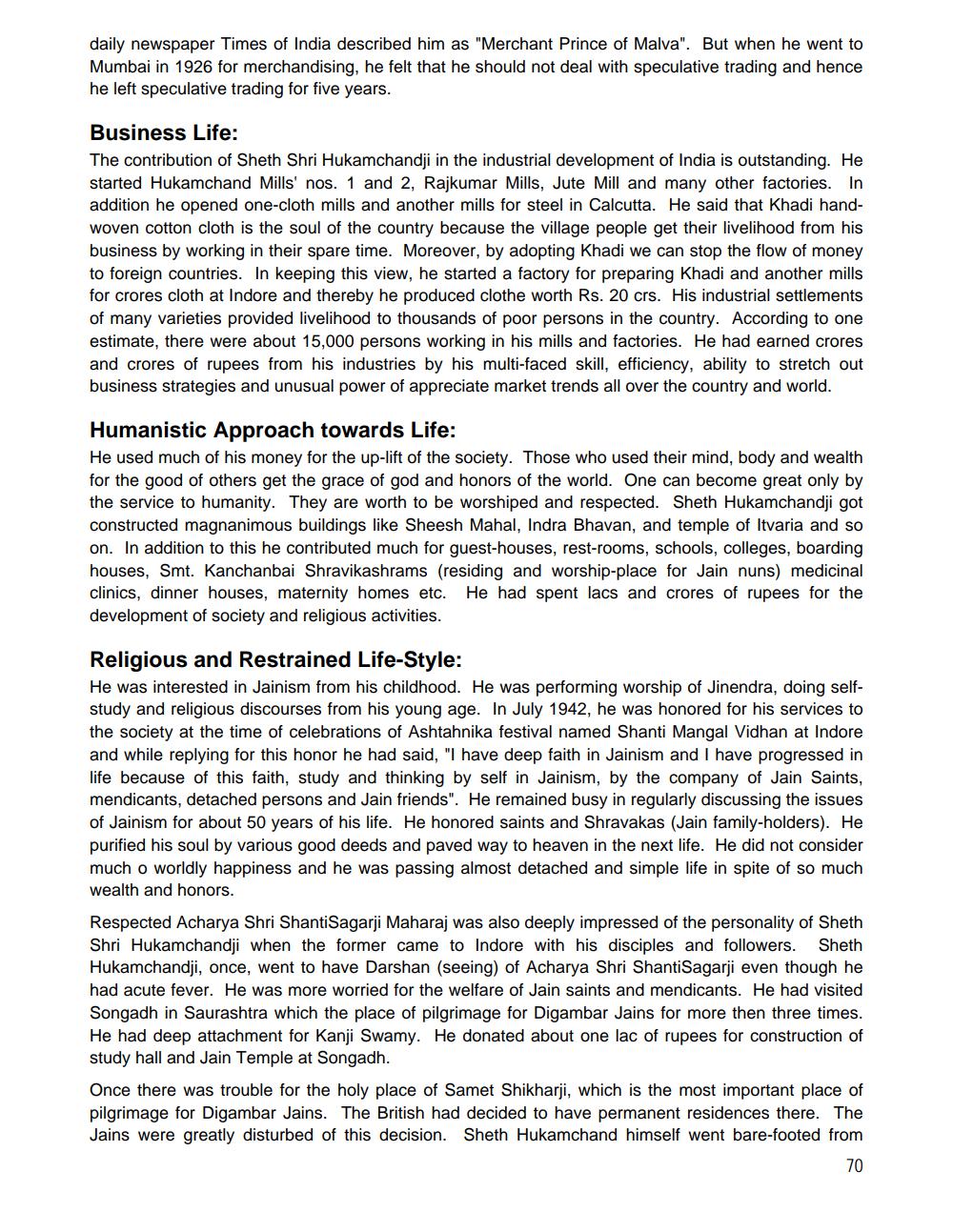________________
daily newspaper Times of India described him as "Merchant Prince of Malva". But when he went to Mumbai in 1926 for merchandising, he felt that he should not deal with speculative trading and hence he left speculative trading for five years.
Business Life: The contribution of Sheth Shri Hukamchandji in the industrial development of India is outstanding. He started Hukamchand Mills' nos. 1 and 2, Rajkumar Mills, Jute Mill and many other factories. In addition he opened one-cloth mills and another mills for steel in Calcutta. He said that Khadi handwoven cotton cloth is the soul of the country because the village people get their livelihood from his business by working in their spare time. Moreover, by adopting Khadi we can stop the flow of money to foreign countries. In keeping this view, he started a factory for preparing Khadi and another mills for crores cloth at Indore and thereby he produced clothe worth Rs. 20 crs. His industrial settlements of many varieties provided livelihood to thousands of poor persons in the country. According to one estimate, there were about 15,000 persons working in his mills and factories. He had earned crores and crores of rupees from his industries by his multi-faced skill, efficiency, ability to stretch out business strategies and unusual power of appreciate market trends all over the country and world.
Humanistic Approach towards Life: He used much of his money for the up-lift of the society. Those who used their mind, body and wealth for the good of others get the grace of god and honors of the world. One can become great only by the service to humanity. They are worth to be worshiped and respected. Sheth Hukamchandji got constructed magnanimous buildings like Sheesh Mahal, Indra Bhavan, and temple of Itvaria and so on. In addition to this he contributed much for guest houses, rest-rooms, schools, colleges, boarding houses, Smt. Kanchanbai Shravikashrams (residing and worship-place for Jain nuns) medicinal clinics, dinner houses, maternity homes etc. He had spent lacs and crores of rupees for the development of society and religious activities.
Religious and Restrained Life-Style: He was interested in Jainism from his childhood. He was performing worship of Jinendra, doing selfstudy and religious discourses from his young age. In July 1942, he was honored for his services to the society at the time of celebrations of Ashtahnika festival named Shanti Mangal Vidhan at Indore and while replying for this honor he had said, "I have deep faith in Jainism and I have progressed in life because of this faith, study and thinking by self in Jainism, by the company of Jain Saints, mendicants, detached persons and Jain friends". He remained busy in regularly discussing the issues of Jainism for about 50 years of his life. He honored saints and Shravakas (Jain family-holders). He purified his soul by various good deeds and paved way to heaven in the next life. He did not consider much o worldly happiness and he was passing almost detached and simple life in spite of so much wealth and honors. Respected Acharya Shri Shanti Sagarji Maharaj was also deeply impressed of the personality of Sheth Shri Hukamchandji when the former came to Indore with his disciples and followers. Sheth Hukamchandji, once, went to have Darshan (seeing) of Acharya Shri Shanti Sagarji even though he had acute fever. He was more worried for the welfare of Jain saints and mendicants. He had visited Songadh in Saurashtra which the place of pilgrimage for Digambar Jains for more then three times. He had deep attachment for Kanji Swamy. He donated about one lac of rupees for construction of study hall and Jain Temple at Songadh. Once there was trouble for the holy place of Samet Shikharji, which is the most important place of pilgrimage for Digambar Jains. The British had decided to have permanent residences there. The Jains were greatly disturbed of this decision. Sheth Hukamchand himself went bare-footed from
70




